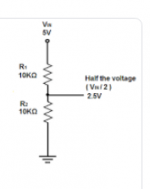I have a pair of 82 rectifiers that take 2.5V for the filaments. My OPT filament AC supply is 5V. So, I took a pair of matched resistors and dropped the 5V down to 2.5V (see schematic attached). The pair of resistors was done on both legs of the AC supply. Without the tube in the socket, this tested OK at the socket pins. 2.5V dead on. Then, I insert the 82 rectifier into the socket and there is no heater voltage. 0.0V measured again at the socket pins. the 82 rectifier does not heat up. I tried this on 2 tubes, but NOS, and neither is heating up. Both tubes have good continuity between the filament pins. Note, only the filament voltage is being applied. No B+, as the rectifiers need to warm up (mercury) prior to B+.
Thoughts?
Thoughts?
Attachments
Last edited by a moderator:
Ohm's law strikes again with its full severity 🙂
You are drawing 4A and expecting to lose 2.5v, right? A 0.625ohm resistor in series with the filament should drop this much and also dissipate 10W, so you actually need a 30W resistor. Seeing this is not a very common value it can be built from a series/parallel combination of resistors. But do you really want to burn so much heat? Rather get an 83 and be done with it. And learn Ohm's law.
You are drawing 4A and expecting to lose 2.5v, right? A 0.625ohm resistor in series with the filament should drop this much and also dissipate 10W, so you actually need a 30W resistor. Seeing this is not a very common value it can be built from a series/parallel combination of resistors. But do you really want to burn so much heat? Rather get an 83 and be done with it. And learn Ohm's law.
be extra careful when you play with mercury. I suggest that you use a 2.5VCT filament transformer instead.
Strongly seconded. Dangerous circuitry and/or parts are for the advanced and knowledgeable user only.
Last edited:
Calculate how much current can flow through one of those 10k resistors and hopefully that rings a bell. Then put this aside for a bit while you read up on electronics because at these voltages beginners mistakes can cost you
Indeed, attempting to "put the horse after the cart"is not wise to do.
Because a LOT of people seem to ignore learning the fundamentals required in electronics.
And they'll always have problems, or worse.
Learn the basics as mentioned here - Ohm's Laws being one of them.
Because a LOT of people seem to ignore learning the fundamentals required in electronics.
And they'll always have problems, or worse.
Learn the basics as mentioned here - Ohm's Laws being one of them.
Your filament needs 2.5V (check) and 3A (not check at all)I have a pair of 82 rectifiers that take 2.5V for the filaments. My OPT filament AC supply is 5V. So, I took a pair of matched resistors and dropped the 5V down to 2.5V (see schematic attached). The pair of resistors was done on both legs of the AC supply. Without the tube in the socket, this tested OK at the socket pins. 2.5V dead on. Then, I insert the 82 rectifier into the socket and there is no heater voltage. 0.0V measured again at the socket pins. the 82 rectifier does not heat up. ... Both tubes have good continuity between the filament pins. Note, only the filament voltage is being applied. .Thoughts?
Your voltage divider is passing 0.00025A so it´s obviously not enough.
Best options are either to get a 5V filament rectifier or a 2.5V center tapped filament transformer, pick one.
Dropping resistors are undesirable kludges.
I would suggest looking at a separate power transformer for the mercury rectifier heaters, and or switch the high voltage AC on after a period of about 45 seconds. so the mercury has time to evaporate.
3B28 are much safer IMHO, your working with a substance that is quite toxic to the nervous system if inhaled/ingested.
3B28 are much safer IMHO, your working with a substance that is quite toxic to the nervous system if inhaled/ingested.
If you have a PAIR of 82 that each need 2.5V and you have 5V and 2.5+2.5=5 why not run the pair IN SERIES? Take the HV from the junction between the tube heaters.... And as others have said, careful with those tubes... And let the filaments warm up for at least 30 seconds before you turn on the HV supply if you want them to last.
Last edited:
- Home
- Amplifiers
- Tubes / Valves
- 82 rectifier 2.5V filament not heating

